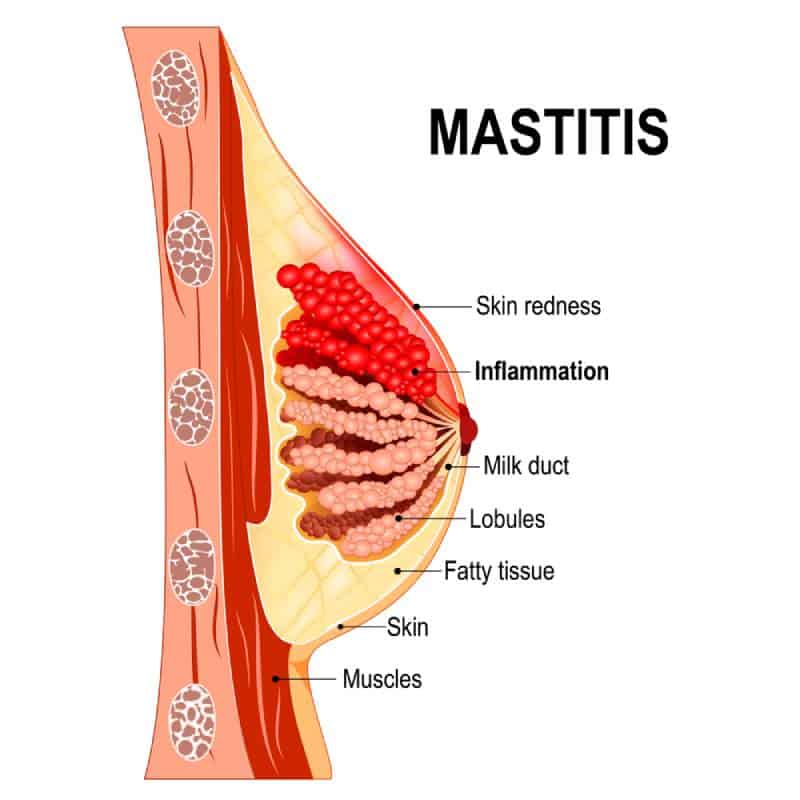You may have noticed that your child has been having some issues breastfeeding. This can all be due to a rather uncommon condition that appears in babies and adults alike – lip tie.
A lip tie is a condition when the frenulum (the band of tissue connecting the lip and the upper front teeth) becomes too stiff, restricting the proper movement of the upper lip.
This makes it difficult for your little one to maneuver her mouth around the nipple to breastfeed.
It’s quite similar to a tongue tie (ankyloglossia), which is a condition that affects the lingual frenulum below the tongue. It appears as oddly short, thick or simply non-flexible, except it affects the tongue instead of the upper lip.
Either of these can make it more difficult for your child to breastfeed freely, but both can make it a straight-up nightmare.
Luckily, as soon as the existence of an upper lip tie is noted, it can be easy enough to get rid of, not to mention that most cases of baby lip ties barely impact the child’s ability to feed. It’s better to be safe than sorry though, just in case.
The Labial Frenulum Isn’t Always A Lip Tie

The labial frenulum is what we call the thin membrane that connects the gumline to our upper lip and it’s meant to be there. There’s absolutely nothing unusual about that.
The way you know if it’s abnormally proportioned or not is if the person – the baby in this case – is having trouble moving her lip.
You can see that if she starts to struggle or showcases some of the potential signs of lip tie interference during breastfeeding.
Potential Problems Your Child Might Have With A Lip Tie
While it’s hard to figure out normally, a newborn lip tie is rather easy to spot during breastfeeding.
If it’s actually posing a problem, you might notice some of these symptoms:
1. Your baby won’t latch properly

While there are many other potential causes to baby not latching or latching poorly, it isn’t too hard to spot that a tight labial frenulum might be the issue if you see your little one’s lip remaining almost stiff during feeding.
They might be trying their best, but it just doesn’t want to budge and they almost always end up with a shallow latch.
2. A lot of wet, smacking noises coming from the baby’s mouth

As the baby moves her lip around to try and maneuver it, it’ll often snap back into place after smacking into their gums due to the shortness of the frenulum.
It’s a common thing that you’ll hear during breastfeeding sessions if she’s affected by the lip tie and is the best indicator of the condition.
3. General difficulty during nursing

It will seem like your little one is severely tuckering herself out during feeding.
This can be exhibited through either shortness of breath, general fatigue, or even the baby often falling asleep in the middle of a breastfeeding session.
She’s trying to struggle against the tight labial frenulum and it’s taking a lot of energy out of her, more than she’d want to exert just to get some food.
Even pacifiers might prove a challenge to a baby with a lip tie, depending on the severity of the issue.
4. Colic

This is a rather common symptom that happens along with nearly every problem in a child’s early life.
Colic is a condition where your child keeps crying constantly without any discernible reason and there’s little you can do about it.
5. Speech issues

If either the lip or the tongue tie is severe enough to a point where moving her lip is rather painful, your child may develop a speech impediment when she becomes older.
It’s best to resolve the issue early, if possible, so it doesn’t come to that.
6. Your baby isn’t gaining enough weight

This is one of the more severe signs if you don’t manage to notice the lip tie right away.
Due to a hindered ability to feed, the baby won’t be getting as much milk out of the sessions as she’d want, leading to her gaining a lot less weight than a baby her age should.
Make sure to track your little one’s progress with a baby scale.
Lacking proof: Higher chance of tooth decay and gum disease

Some researchers claim that tightened frenums leading to frequent feeding sessions and the overall hindered mobility functions of the mouth can lead to accumulations of breast milk and other food on the upper gums.
This gives bacteria an easier spot to latch onto and feed, affecting your baby’s teeth and giving them more cavities.
While not ideal, that theory is, as of yet, still lacking enough evidence to be backed up, but is something to take into consideration.
Problems Moms Suffer From When Their Baby Has Lip Tie
Now, your kids aren’t the only ones who have issues arise due to a tightened labial frenum.
All of the issues listed above can and will lead to some breastfeeding problems for you that might be rather uncomfortable.
1. Breast engorgement

You may think a feed has gone by nicely, but in reality it hasn’t.
Your baby didn’t drain out all the milk from your breasts during that feed and some of it remained.
Shortly after you’ll start feeling your nipples get sore and your breasts start to ache.
That’s what’s called breast engorgement. It’s a rather common side effect of a poor latch and you can blame lip and tongue ties for that in this case.
You might need to hand express a little bit of milk after each feed to help relieve the breast engorgement issues.
2. Clogged milk ducts

A slightly different, but equally painful side effect can be clogged milk ducts.
All the fatty milk that remains in your milk ducts due to an unfinished session can end up clogging your milk ducts and causing you quite a bit of breast pain as a result.
Make sure that, if you’re still feeding your child and she has a frenulum issue, you always finish the feeding off either via a pump or hand expressing some milk until the breasts are empty.
3. Having to breastfeed more often

This stems from the problem of the baby not getting enough food, which will lead to her wanting to breastfeed more often yet never feeling sated because she never gets the right amount of milk in.
Too many feedings will start giving you sore and worn out nipples from all the gnawing and tugging, plus they’re bound to be a lot more exhausting than your regular routine.
Depending on the alternation of the breastfeeding sessions, your milk supply levels might end up being affected, leading to either having an undersupply or oversupply of milk.
And that’s a whole another set of breastfeeding issues on its own.
4. Mastitis

Mastitis comes from the same branch of issues as clogged milk ducts and breast engorgement do, and that’s usually due to an oversupply of milk.
It’s a condition that describes when your breast tissue becomes inflamed or infected, which causes a lot of breast and nipple pain, depending on where it ends up occurring on the breast itself.
The space around the areola is probably one of the most painful ones should it occur there.
Albeit temporary, it can be a recurring side effect for as long as the tight labial frenulum remains an issue.
What To Do If You Notice Breastfeeding Difficulties With Your Child?

Should you spot any of these symptoms, you should take your child to a pediatrician or a lactation consultant to have a feeding evaluation.
It’s there that the healthcare provider is going to determine whether or not a lip or tongue tie is the problem here, or if there’s something else afoot like a wrong latch or something similar.
How To Get Around The Lip Tie Hindrance

As hard as this may be to hear, the best way to go about feeding your child if they have either of the two ties is to opt for feeding supplements and refrain from breastfeeding.
Relying on bottle feeding is preferred in this case, since the baby will have an easier time drawing milk out of it.
Either your own milk or a baby formula works – as long as your little one is getting all the nutrients that she needs.
She needs to continue developing and alternatives have to be found.
While this may end up having you two bond less and inducing some nipple confusion later down the line when the lip tie is mended, it’s still the best choice for your baby.
Though, you will need to continue pumping rather frequently still if you intend to continue breastfeeding your baby once the issue has been resolved.
My personal suggestion is to sync your pumping sessions to your baby’s feeding periods so your body develops a natural clock for when it’s time to breastfeed again.
Plus, frequent pumping will help keep your milk ducts clear and prevent any of those problems mentioned earlier from occurring.
Now, if you’re really adamant about staying all-natural and you want your baby to only feed from your own breast, you can still technically do it, but I personally wouldn’t recommend it.
It’s way more trouble than it’s worth, but, in case you want to try yourself, you’ll have to learn proper baby latching positions and also pre-soften your own nipple.
You can do this by swabbing a bit of saliva from your baby’s mouth with a clean finger gently and then using it to massage the nipple and soften it up.
You can’t really use your own, since your mouth may contain bacteria that could transfer something unpleasant to your little one. (Besides, nobody likes having someone else’s spit in their mouth!)
Finally, if none of these methods are helping, always resort to your lactation consultant or pediatrician about proper alternative feeding methods – ones that they can determine a lot better due to hands-on experience.
How To Remedy Lip Ties

There are two methods generally recommended when having to deal with tight or inflexible frenulums.
The first one is called lip tie revision and it’s one that you can yourself over the course of time.
It’s a rather easy one to perform too! Simply fit your finger between the lip and your baby’s upper front teeth and slide it along to help loosen the area up.
This will help the upper frenulum loosen itself up too, which will eventually lead to increased lip mobility.
This procedure is recommended for milder cases of frenum tightness and older children can perform it on themselves (but older children won’t really need to breastfeed anymore).
For the more severe cases, there’s a different method called laser frenectomy.
This is something that you yourself cannot perform, but a procedure left to skilled pediatricians and pediatric dentists.
The process itself involves severing the frenum connecting the lip and the upper gum line through the use of a laser or a precise surgical scissor.
You may think that such a procedure would cause your baby a lot of pain, but luckily it is almost painless, with your little one only feeling a little momentary sting at best.
The same procedure is utilized in case of posterior tongue ties too.
These processes of lip and tongue tie release don’t take too long to take effect and the baby will be feeling a lot better later when she gets to breastfeed normally again.
There isn’t much evidence on the fact that a tongue or lip tie release offers much relief.
But, there were some studies enacted on a few hundred people that showed amazing improvements in lip and tongue mobility right after the procedures.
In Summary
A lip tie in babies is easy to deal with but can be a real nuisance when left undiscovered, with many issues that affect breastfeeding.
From a shallow latch and gassiness at times from swallowing too much air, to abnormalities in milk supply for the mamma and poor weight gain for the child in question.
These tightened frenums can even cause some speech problems down the line, but a quick frenectomy can sort that out rather quickly.
Whatever the case, always make sure to contact your local IBCLC (lactation consultant) or pediatrician for more specialized help if your child ends up being a unique case.
References:
Flinke A, et al. (1994). Oral findings in a group of newborn Swedish children.
READ NEXT: Baby Sucking Bottom Lip (Causes And Treatments)
Like this post? Please share or pin it for later. You can also stay in the loop and follow us on Facebook, Instagram and Pinterest.

This post contains affiliate links. Please see our full disclosure or more info.

